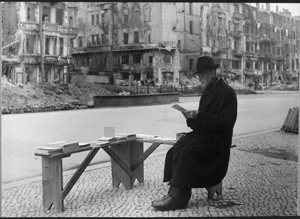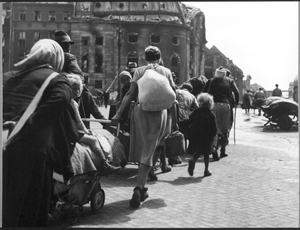1/11/2011
Jindřich Marco: Photographs from the Years 1945-1948
 |
| Jindřich Marco, Warsaw, 1947 |
For three years, the Czech photographer Jindrich Marco (1921 - 1999) documented the clean up after the deadliest of wars in Europe. More than on the ruins of the destroyed cities he concerned on people trying to re- build their houses, schools, railway stations and factories again as well as their everyday lives. He created extremely powerful set of dozens of images, which within Czech documentary photography can be compared only to Zdeněk Tmej’s series on the total mobilization of young Czech men, published in the book The Alphabet of Spiritual Emptiness (1945, new edition New York, 2011). Marco’s photographs are not concerned with the external drama, they are not pathetic and show neither killing nor fires, but through the deep conviction and the author’s personal experience portray the lives of ordinary men, women and children, radically changed by the war. We find no generals or presidents there, but people just like us. They depict the negation of the usual order and of normal values, ghostly ruins of once imposing palaces, churches and houses, human pain, suffering, humiliation, despair, fear and fatigue, but also hope of return to normal life. These pictures are true documents of Berlin, Dresden, Warsaw, London, Budapest and other cities immediately after World War II and although they do not capture any battle scenes, they represent the valid symbols of barbarism of war on more general level. Like the photographs of Robert Capa, Margaret Bourke-White, Leonard McCombe, Werner Bischof, Yevgeny Khaldey and other photographers of that time, they show the suffering, but also the people who even after all the horrors, all the impoverishment and mental and physical mutilations did not loose the power to struggle for their lives. Most of Marco’s snaps catch our attention immediately and we often have the impression that we are standing unseen by anyone in the middle of the scene. Marco had a sense for eloquent detail and for creative confrontation of different motifs, which contribute to the fact that his photographs carry, often alongside the intentionally captured scene in front of the lens, also a more symbolic second plan in the subtext of meaning, that reality is not just displayed by them, but interpreted.
 |
| The First Bookseller, Berlin 1945 |
 |
| Refugees from the East, Berlin_1945 |
And they also reveal few things about the attitudes and opinions of the author himself. He captured the stories of ordinary people who themselves were not responsible for the war, but whose lives were radically changed by the war and who suffered tremendously and long after the war was over. Marco's photographs of ruins of German cities, of street markets or life in Hungary during the hyperinflation were published mainly by the new Prague weekly Svět v obrazech (World in Pictures) and other Czechoslovak magazines, but thanks to agencies such were Black Star and later Pix they could be seen also on the pages of the legendary American Life and British Picture Post, Lilliput and Weekly Illustrated magazines or in the French Paris Match weekly. In March 1947, at the request of foreign agencies and ČTK, Marco left to Warsaw to cover the process with the prominent Nazis. It was his first time in the Polish capital, which during the war suffered probably the greatest damage of all European cities. It is this city where Marco's best-known picture comes from: in the middle of the ruins of Warsaw city center a street photographer portrays two soldiers in front of the background with an idyllic landscape painted on. This almost surreal image is not just a particular document from a certain place and time, but it is an anti-war memento in the full sense of this word. Its symbolic significance was acknowledged when it became the final image at the Foto: Modernity in Central Europe, 1918-1945 exhibition, held at the National Gallery of Art in Washington and the Guggenheim Museum in New York in 2007 and 2008. Strong emotional appeal is characteristic for many other Marco’s Warsaw images as well as for his coverage of huge floods in the basin of the Vistula. The street snapshots from London, published as part of his book England in Words and Pictures, completed his series on the postwar life in Europe.
Marco's career of leading photojournalist briefly continued as he documented the fights during the 1948 Middle East war, where he captured the Jewish immigrants after their arrival to Haifa, fighting in the Negev desert, the children in the Orthodox religious school in Jerusalem and Arab prisoners. In the following period of still escalating Cold War Marco could not continue his work for the Brithis and the U.S. photographic agencies. In June 1950, he was arrested and later in the trumped-up trial unconditionally sentenced to ten years, reduced to seven years in Jáchymov uranium mines. After his release, he prepared several ethnographic picture books and professional books on numismatics and graphics, dozens of portraits of artists, took romantic shots of Prague, under the pseudonym Václav Svoboda published a book in Austria from occupation of Prague in August 1968. But he never created stronger photographs such were those from the period 1945-1948. At the end of this year, his memoirs are to be published by Torst publishing, Prague..
Vladimir Birgus
curator of the exhibition
Jindřich Marco was born on 10 May 1921 in Prague in the family of a bank clerk. During the studies at real-gymnasium, he began to publish his firs photographs. From 1941-1943 he worked as a photographer in printing enterprise Family in the agency Arts - service to artists. In October 1944, because of his partly-Jewish ancestry, he was interned in a labor camp Kleinstein in Opole, from where he managed to escape at the beginning of 1945. After the dramatic journey he reached in March Košice, where he was authorized to establish the Photographic Department of the Ministry of Information of the Czechoslovak government. In this office, he began in Budapest with the capturing of war-torn European cities. Since May 1945 he worked as a photojournalist in Prague for a new World in Pictures weekly and later collaborated with the LCI, Black Star, Inc. PIX., AFP agencies. In 1948, he photographed in Israel. In 1950 he was arrested and after the trumped-up and political trial sentenced to ten years in jail. But for most of his sentence, he worked in the Jáchymov mines. After his release in 1957, he photographed mainly for various magazines and published ethnographic photographic publications and books in the field of numismatics and graphics. In 1968 in Vienna, he published a book of photographs from the occupation of Prague Genosse Agresor, under the pseudonym Václav Svoboda. His photographs of postwar Europe were published in the books Please Buy My New Song (Artia, Prague 1967) and Bitter Years Europe 1945 - 1947 (Orbis, Prague 1995, text Vladimír Birgus). He died in Prague on 20th December 2000.

